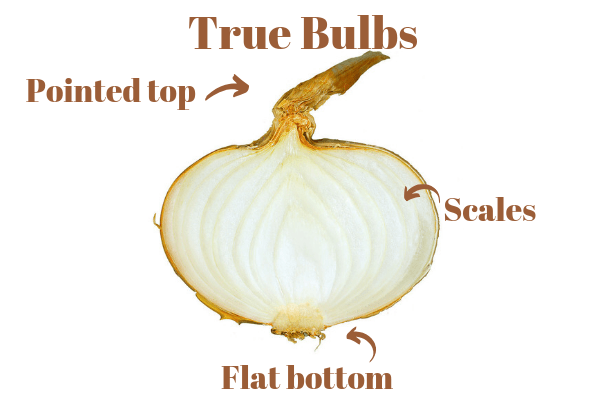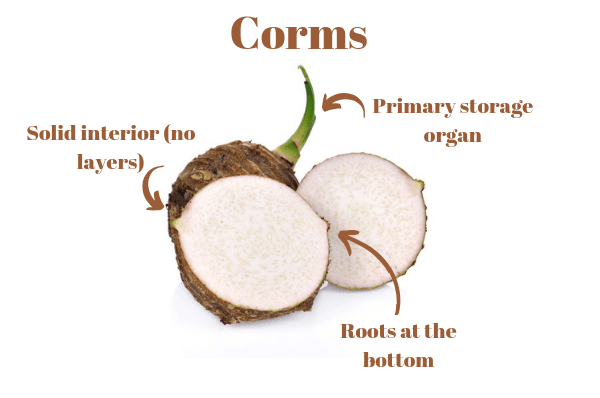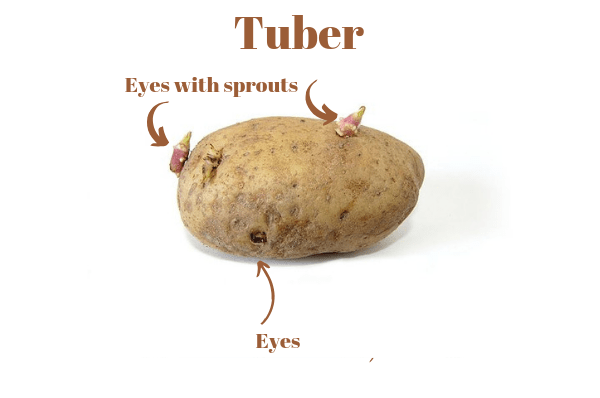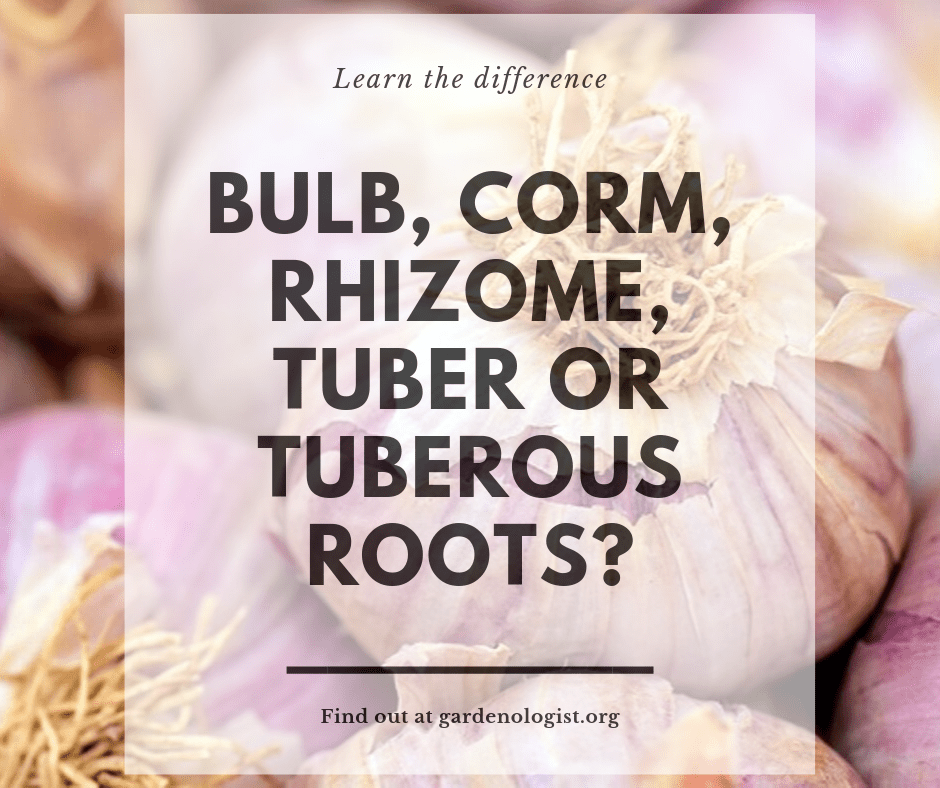This post may contain affiliate links. As an Amazon Associate we earn from qualifying purchases.
Most gardeners use the term “bulbs” to describe those hunks, often with roots, that they throw in a hole they’ve dug for it in spring or fall.
And, that’s ok. But as gardeners progress, and begin seeking more detailed information on planting and caring for their bulb-originated plants, they’ll find that those underground structures are often not “true” bulbs, but referred to as a rhizome, corm, tuber or tuberous root.
While all types of bulbs are food-storage organs, there are differences.
Are these important to understand?
Yup. Read on to find out why.

True bulbs
The easiest way to identify a true bulb is by its flat bottom and pointy top; they are typically round in shape.
Every time you cut into garlic or an onion remember that you are cutting into a true bulb. Other plants that grow from true bulbs include:
- Allium
- Amaryllis
- Asiatic lily
- Daffodil
- Dutch iris
- Grape hyacinth
- Hyacinth
- Lily (true lilies)
- Tulip
True bulbs, like the onion, have layers (known as “scales,” which are actually leaf tissue).
Planting depths vary, but the rule of thumb is to plant them twice the height of the bulb. This means about 6 inches deep for daffodils and tulips and about 3 to 4 inches in depth for smaller bulbs.

Corms
Corms often resemble true bulbs without the layers. Another difference of note is that the bulb’s primary storage organ is the leaf tissue (what we see as “layers” in the onion) while the corm’s is the stem.
Some corms have fuzz on the surface and all have a solid interior. Buds sit at the top of the corm and the roots and baby corms (known as “cormels”) sit on the underside.
Popular plants that grow from corms include:’
- Anemone blanda (Grecian windflower)
- Crocus
- Freesia
- Gladioulus
- Taro
- Water chestnuts
- Water lily
- Watsonia
Freesia corms, for instance, require 2 inches of soil over them at planting, while Watsonia corms should be planted twice as deep.

Rhizomes
We like Wikipedia’s simple definition of a rhizome: “a modified subterranean plant stem that sends out roots and shoots from its nodes.”
Rhizomes typically grow horizontally, not vertically, sending out side shoots from the main root. But they also send out shoots from “eyes” sprinkled across the top and sizes of the rhizome. These will grow upward.
When you picture common plants that grow from rhizomes, the definition makes a lot more sense:
- Bamboo
- Calla lily
- Canna lily
- Cattail
- Chinese lantern
- Fortnight lily, butterfly iris
- Ginger
- Heavenly bamboo
- Iris
- Liriope spicata
- Many ferns (Osmunda claytoniana; Blechnum spicant; Nephrolepis exaltata and others)
- Papyrus
- Poplar
- Tansy (Tanacetum vulgare)
- Turmeric
- Virginia creeper
Many weeds and invasive plants also are the product of rhizomes, including:
- Bermudagrass
- Creeping Charlie
- Dallisgrass
- Hedge bindweed
- Horsetail
- Japanese knotweed
- Mugwort
- Pennywort
- Poison ivy
- Stinging nettle
- Yellow and purple nutsedge
Propagation of rhizomes is easy – just choose a section with at least one “eye,” and plant it about two to three inches the rhizome piece’s height.
Be aware that certain rhizomatous plants have very specific planting depths, so check before tossing it into a hole.
An example of this is bearded iris, which requires allowing the very top of the rhizome to remain exposed unless you live in an area with hot summers, then you’ll want to set it just below the soil’s surface.
For more information on planting iris rhizomes, see the American Iris Society’s website.

Tubers
Tubers also have “eyes,” from which the plant will bud. They, like the others, grow underground stems which, like corms, serve as the primary storage organ.
Interestingly, the yam is a tuber while the sweet potato is a tuberous root.
- Anemone
- Begonia
- Caladium
- Cyclamen
- Oxalis
- Potato
- Yam
- ZZ plant (Zamioculcas zamiifolia)
If you’re interested in the difference between yams and sweet potatoes, head over to Oregon State University’s website for more information.

Tuberous root
If the root tissue is enlarged and fleshy, such as that of the dahlia, the plant has what is known as a tuberous root. The fleshy tissue is the primary storage tissue and buds are located primarily at the stem-end or crown of the plant.
As mentioned earlier, the sweet potato (which isn’t actually a potato) is a tuberous root. Other familiar plants with tuberous roots include:
- Agapanthus
- Certain species of iris
- Dahlia
- Daylily
- Peony
- Ranunculus
The best propagation method for tuberous roots plants is by crown division, with each piece bearing several “eyes” and enough roots to support the growing plant.
So, why do I need to know this?
“Understanding how plants grow is essential to being a good gardener,” according to Marian St. Clair, master gardener in Greenville, South Carolina.
But it’s more than that.
Let’s take rhizomes, for instance. It’s wise to divide canna lily plants at least every-other year. Understanding what happened beneath the soil over the past two years allows the gardener to more intelligently dig up the rhizome, divide it and either replant or store the pieces over the winter.
Remember, rhizomes grow horizontally, so while that canna was giving a brilliant flower show all summer long, beneath the soil it was growing sideways. With this knowledge, you have a better idea of where to insert the shovel to dig it up (hint: it’s not at the base of the plant).
Now you know!
You’ll find other gardening terms demystified here, here and here and more coming in the future.




